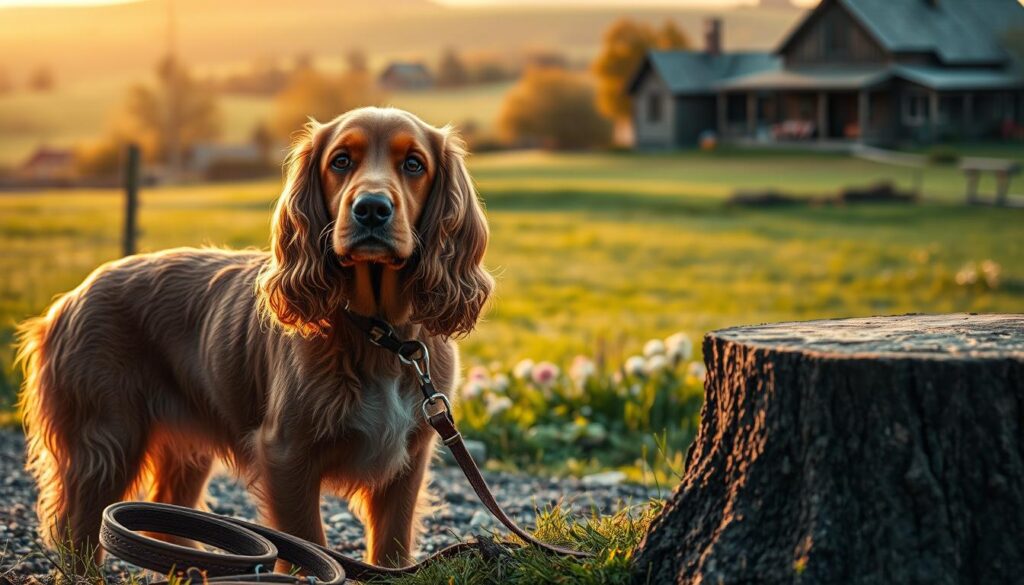With their silky fur and expressive eyes, this breed has won hearts worldwide. Originally skilled hunting partners, these dogs now excel as devoted family members. Their ability to adapt from active fieldwork to relaxed home life highlights their versatile personality.
Known for forming strong bonds with owners, they thrive on companionship. Their eagerness to please makes them responsive to positive reinforcement during training. Daily interaction and mental stimulation are crucial to keep their cheerful energy balanced.
Understanding their background helps owners meet their needs effectively. Regular exercise maintains their athletic heritage, while gentle grooming preserves their iconic coat. Socialisation from puppyhood ensures they remain confident around people and other pets.
Key Takeaways
- Adaptable nature allows smooth transition from working dogs to household companions
- Require consistent social interaction to prevent separation anxiety
- Intelligent and responsive to reward-based training methods
- Regular brushing needed to maintain coat health and prevent matting
- Moderate exercise requirements suit various living situations
- Early socialisation shapes confident adult behaviour
Overview of Cocker Spaniel Temperament
These charismatic companions carry centuries of purpose in their DNA. Originally bred to flush woodcock in European forests, their evolution mirrors changing human needs. Modern lines showcase careful balancing of working drive and home-friendly qualities.
Historical Background and Evolution
Fourteenth-century records first mention spaniels specialised in bird flushing. By the 1800s, two distinct types emerged: larger land spaniels and compact “cockers”. The American variant developed later, prioritising companion traits like softer features and manageable size.
This selective breeding created dogs equally comfortable retrieving game or curling on laps. Hunters valued their focus and stamina, while families adored their cheerful loyalty. These dual roles forged adaptable personalities suited to diverse lifestyles.
Defining Key Traits
Three core qualities define the breed’s character:
- Eager responsiveness to human guidance
- Natural enthusiasm for play and work
- Strong preference for social interaction
| Era | Primary Role | Key Traits |
|---|---|---|
| 14th Century | Game Flushers | High stamina, sharp senses |
| 19th Century | Show Dogs | Stylish appearance, calm demeanour |
| Modern Day | Family Pets | Affectionate nature, adaptable energy |
Today’s lines retain their ancestors’ intelligence while embracing domestic life. Regular mental challenges paired with affectionate bonding sessions keep them content. Their ability to switch between active play and quiet companionship makes them ideal for Australian households.
The Origins and Heritage of Cocker Spaniels
Centuries of specialised breeding crafted dogs equally capable in wetlands and living rooms. Selective adaptation transformed skilled hunters into devoted home companions while preserving their spirited nature. This duality remains central to understanding their care needs today.

From Hunting Dogs to Family Companions
Early breeders prioritised traits like water-resistant coats and athletic builds for retrieving game. As hunting declined, enthusiasts reshaped the breed for companionship. American lines developed shorter muzzles and luxurious fur, while English variants retained more working-dog features.
Modern dogs display this blended heritage through:
- Spring-loaded enthusiasm during fetch games
- Persistent sniffing during neighbourhood walks
- Instinctive head tilts when hearing bird calls
Influence of Working Background on Behaviour
Field-bred stamina translates to impressive endurance in family settings. A 30-minute walk often becomes a scent-tracking mission, with noses tracing invisible trails. Water activities like paddling pool play or beach visits frequently become favourite pastimes.
| Historical Trait | Modern Manifestation | Management Tip |
|---|---|---|
| Game flushing | Chasing squirrels/balls | Secure fencing essential |
| Silent hunting | Stealthy food scavenging | Use puzzle feeders |
| Pack cooperation | Family integration | Group training sessions |
Owners channel these instincts through structured play. Retrieving games satisfy natural drives, while scent trails in backyards provide mental workouts. Regular swimming sessions honour their aquatic heritage while burning energy.
Key Characteristics of Cocker Spaniel Temperament
These adaptable pets shine in family environments, blending enthusiasm with emotional awareness. Their ability to read human cues sets them apart from many breeds, creating relationships built on mutual understanding.
Affectionate and Social Nature
Families often describe these dogs as shadow companions who participate in daily routines. Morning school runs become sniffing adventures, while evening TV time means curled-up cuddles. Early socialisation helps them bond smoothly with new pets, though supervision remains wise around smaller animals.
| Personality Trait | Family Impact | Care Strategy |
|---|---|---|
| Emotional Awareness | Detects mood changes | Maintain calm environments |
| Playful Energy | Encourages outdoor activities | Schedule daily fetch sessions |
| Social Needs | Strengthens household bonds | Include in group activities |
Sensitivity and Intelligence
Their sharp minds excel at learning tricks but wilt under harsh corrections. Positive reinforcement with treats or praise yields better results than stern commands. Many owners report their pets anticipating routines, like fetching leads before walk times.
This breed’s emotional depth makes them excellent comforters during stressful periods. However, loud arguments or chaotic environments can cause anxious behaviours. Consistent routines and gentle guidance help maintain their sunny disposition.
Unpacking cocker spaniel gentle temperament
This breed’s emotional intelligence shines through its unique blend of serenity and perceptiveness. Their calm presence makes them ideal for homes with children or elderly residents, while their alert curiosity suits active outdoor lifestyles.

What Sets Them Apart
Three elements define their distinct personality:
- Emotional mirroring – They adapt their energy levels to match household moods
- Situational awareness – Quick to notice routine changes or new visitors
- Conflict avoidance – Prefer retreating over confrontation during stress
These dogs thrive in structured settings where they feel included. Morning walks to local parks or weekend beach outings become bonding rituals. Their ability to switch between playfulness and relaxation helps them fit various Australian lifestyles.
Owners should note their sensitivity to loud noises and chaotic environments. Stormy weather or bustling gatherings might require quiet spaces for retreat. Consistent bedtime routines and predictable meal times reinforce their sense of security.
| Trait | Household Benefit | Management Tip |
|---|---|---|
| Patience | Tolerates children’s play | Supervise interactions |
| Adaptability | Adjusts to urban/rural living | Provide varied experiences |
| Empathy | Supports emotional wellbeing | Maintain calm communication |
Proper care involves more than physical needs – their emotional world requires attention too. Regular grooming sessions double as bonding opportunities, while puzzle toys keep sharp minds engaged between adventures.
Training Techniques with Positive Reinforcement
Effective training shapes well-mannered companions through methods that align with their learning style. Reward-based approaches build trust while encouraging cooperation, making lessons enjoyable for both handler and dog.
Effective Methods for Gentle Training
Immediate rewards create clear behaviour connections. Treats given within 2 seconds of compliance reinforce actions best. Pair snacks with phrases like “Good sit!” to strengthen understanding. Puppy classes offer structured environments for mastering basics like recall and leash manners.
Short 10-minute sessions prevent mental fatigue. End each practice with success – even repeating known commands builds confidence. Mix playtime with drills to maintain engagement. A game of fetch after practising “drop it” keeps energy positive.
| Technique | Application | Result |
|---|---|---|
| Clicker Training | Marks exact moment of compliance | Accelerates command association |
| Food Puzzles | Teaches problem-solving | Reduces boredom-related chewing |
| Mirror Training | Imitates owner’s movements | Strengthens focus and bonding |
Creating a Consistent Routine
Daily practice at fixed times helps dogs anticipate learning. Morning sessions after breakfast capitalise on alertness. Evening reviews before walks utilise motivation. Family members should use identical commands – “down” versus “lie down” causes confusion.
Advanced activities like scent trails or agility courses channel natural instincts. These build on foundational skills while preventing behavioural issues. As one trainer notes: “Consistency turns momentary successes into lifelong habits.”
Daily Exercise and Mental Stimulation
Active companionship forms the cornerstone of maintaining these spirited dogs’ wellbeing. Their heritage as working animals demands structured outlets for energy, blending physical challenges with cognitive engagement. A balanced routine prevents restlessness while nurturing their natural curiosity.
Fueling Body and Mind
These lively companions thrive on 45-minute activity blocks split between movement and problem-solving. Morning adventures might include:
- Bushwalking with sniff breaks for environmental exploration
- Retrieving games using floating toys in backyard pools
- Scent trails using hidden treats around the garden
Afternoon sessions could feature interactive feeders that dispense snacks during quiet time. Rotating three different puzzle types weekly prevents boredom. As one trainer advises: “Mental workouts tire them as effectively as physical runs.”
| Activity Type | Duration | Benefit |
|---|---|---|
| Leashed Walks | 20 minutes | Joint-friendly cardio |
| Agility Drills | 15 minutes | Coordination development |
| Food Puzzles | 10 minutes | Cognitive engagement |
Owners report calmer behaviour when combining swimming sessions with nose work. Evening wind-downs might involve chew toys stuffed with frozen peanut butter. This rhythm supports their need for both exertion and relaxation.
Grooming Essentials for a Healthy Spaniel
Proper coat maintenance forms the foundation of canine wellbeing for this breed. Their luxurious fur demands strategic care to balance beauty with practical health considerations. A thoughtful care routine prevents common issues while preserving their signature appearance.
Maintaining a Silky, Tangle-Free Coat
Weekly brushing sessions with a slicker brush keep feathered areas smooth. Focus on friction zones behind ears and under legs where mats form easily. Many owners alternate between wide-tooth combs and detangling sprays during grooming time.
Bathing every month with oatmeal-based shampoo maintains natural oils. Always dry thoroughly between skin folds to prevent irritation. Professional trims every 6-8 weeks help manage overgrown paw hair and feathering.
Preventing Ear Infections and Other Issues
Floppy ears create warm environments where moisture lingers. Weekly inspections using vet-approved cleansers reduce ear infections risk. Look for redness or unusual odours during checks.
Complementary care includes monthly nail trims and dental wipe routines. These steps protect mobility and prevent gum disease. For cocker spaniel owners, combining grooming with playtime makes maintenance enjoyable rather than stressful.



